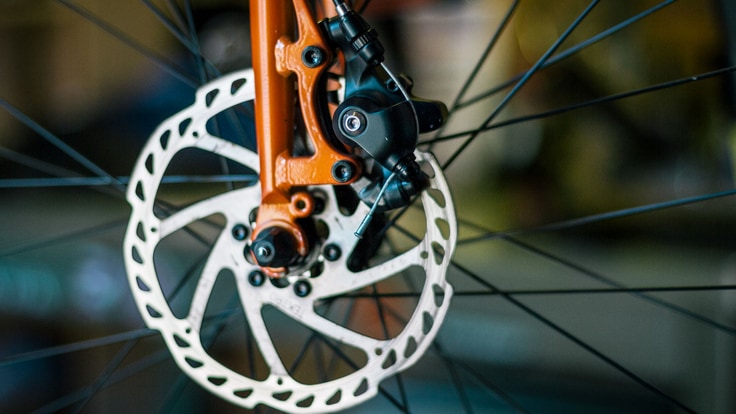Even the most speed-obsessed cyclist would agree that what goes forward must eventually stop (preferably under control). That's where your brakes come in, and knowing the differences between types of bike brakes can help you choose the option that's best for the way you ride.
There are four types of bike brakes: rim, disc, coaster or drum brakes. On a majority of bicycles today, though, you'll find either rim brakes or disc brakes.
Rim brakes vs. disc brakes: Once the dominant braking system on bikes, rim brakes, as their name suggests, stop the bike by squeezing two opposing brake pads against the rim of the bike wheel. The brake mechanisms are mounted on the frame somewhere near the upper part of the wheels. In comparison, disc brakes sit at the center of each wheel and stop the bike by squeezing a brake pad against a rotor mounted around the hub. They feature superior stopping power, especially in sloppy conditions. Once found only on mountain bikes and a few road bikes, disc brakes are now found on all categories of bikes.
Mechanical vs. hydraulic disc brakes: At the top end of the performance spectrum, hydraulic disc brakes differ from mechanical disc brakes in how the brake pads are controlled. Hydraulic systems have fluid-filled brake lines, while mechanical disc brakes (like rim brakes) use cables to move the pads. Hydraulic brakes offer a smoother, more responsive performance than either of the other brake systems. In addition, as the brake pads wear, the system automatically adjusts their position to maintain good contact with the rotor when the brakes are applied. In nonhydraulic systems, you have to manually readjust the position of the pads periodically as they wear. As a result of the self-adjusting feature, hydraulic disc brake performance is more consistent.
Here are the main factors to consider when choosing the type of brakes you want for your bike:
- All-conditions performance: Disc brakes are the clear winner, in part because they are positioned farther from the moisture and muck that your wheels can spin up from a road or a trail. Experienced rim brake riders improve performance by lightly tapping the brakes to squeegee off the rims before they need to apply full braking power.
- Responsiveness: Disc brakes, particularly hydraulic disc brakes, offer a smoother, more consistent feel through a full range of braking force. Another slight shortfall of rim brakes is that they can overheat if the brakes are applied forcefully over a long period of time—that can cause braking power to fade.
- Rim life: Disc brakes are the big winner because rim brakes will eventually wear out your rims. Regular bike commuters might go through a set of wheels every few years. Keeping rims clean will help your rims last longer—and help your brakes perform better in the meantime.
- Ease of flat repair: Though not a huge difference, disc brakes get the nod because you don't have to disengage the calipers (metal arms that hold the brake pads on rim brakes) before the wheel can be pulled free of the bike. Plus, the rims on disc wheels stay cleaner so your hands will too.
- Maintenance: Rim brakes are simpler and less expensive to maintain because disc brakes require routine maintenance on a more rigorous schedule. More people are also comfortable doing routine maintenance on rim brakes, which further saves on shop costs. Even though hydraulic disc brakes save a task because they self-adjust as the pads wear, the pads still need to be inspected regularly and replaced as needed. Additionally, the lines must be bled regularly—to purge air bubbles from the system—to ensure they work properly. So if you have hydraulic disc brakes, bleeding them will be a separate shop (or home) repair chore.
- Cost: Rim brakes get the nod here, although the bigger related consideration is that rim brakes' regular maintenance costs are lower.
Looking for a quick recommendation? If you plan to ride frequently in poor weather, such as commuting on a regular basis, you'll appreciate the performance benefits of disc brakes—hydraulic disc brakes in particular if you want the ultimate in smooth, consistent braking performance. If you're a casual, fair-weather rider and want to keep costs down, rim brakes will probably work for you just fine.
Is it possible to change your bike from rim brakes to disc brakes? Practically speaking, it's not. The braking forces on the frame for a bike designed to have disc brakes are different from those on a bike that has rim brakes. The frame and fork on a bike with disc brakes are designed with additional reinforcement and mounts to accommodate the disc-brake calipers. If you have a bike that was built when disc brakes were still a new thing, it might have mounts for both disc and rim brake systems, but you'll still need a new set of wheels that are disc-brake specific. So, in general, if you prefer disc brakes you'll need to get a bike that already has them.
Other Types of Bike Brakes
Coaster brakes: Those brakes you (or your parents) had on your bike as a kid, where you simply pedal in reverse to lock the rear wheel in place, are still found on kids' bikes. They're also found on casual rigs like cruiser bikes. There will always be a place in this world—and fans—for low-complexity tech.
Drum brakes: These work just like drum brakes in a car: Curved brake shoes push outward against the inner surface of an enclosed drum at the hub of the wheel. Because the braking surface is shielded from rain, drum brakes perform well in wet conditions. The downside is that they can overheat, especially on long downhill sections. So drum brakes are mostly found on utility bikes designed for use in flat terrain and wet weather.

